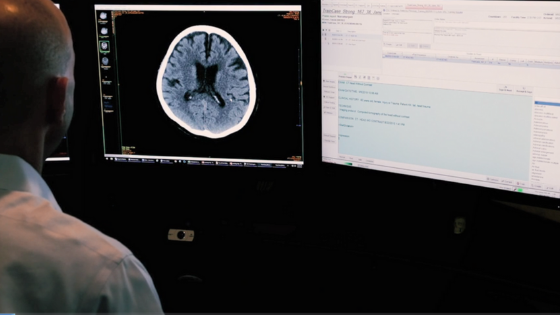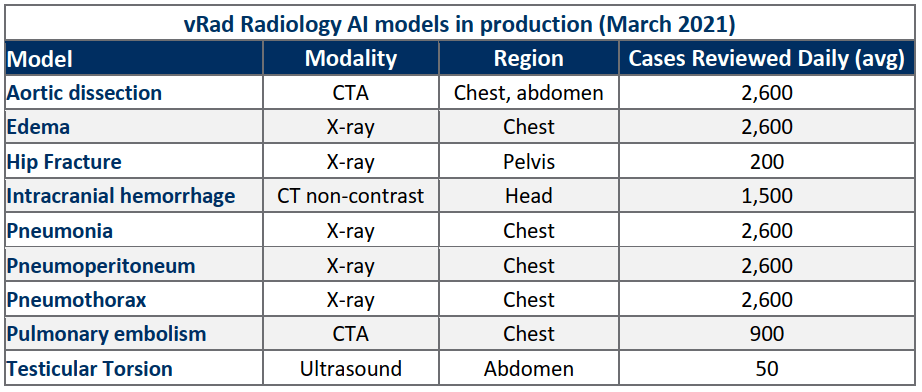AI in Radiology: Making an Impact Today and Charting a Path to the Future
Beyond theory, vRad is using practical AI to impact patient care today, while paving the way to the future of radiology.

Remote radiologist jobs with flexible schedules, equitable pay, and the most advanced reading platform. Discover teleradiology at vRad.

Radiologist well-being matters. Explore how vRad takes action to prevent burnout with expert-led, confidential support through our partnership with VITAL WorkLife. Helping radiologists thrive.

Visit the vRad Blog for radiologist experiences at vRad, career resources, and more.

vRad provides radiology residents and fellows free radiology education resources for ABR boards, noon lectures, and CME.

Teleradiology services leader since 2001. See how vRad AI is helping deliver faster, higher-quality care for 50,000+ critical patients each year.

Subspecialist care for the women in your community. 48-hour screenings. 1-hour diagnostics. Comprehensive compliance and inspection support.

vRad’s stroke protocol auto-assigns stroke cases to the top of all available radiologists’ worklists, with requirements to be read next.

vRad’s unique teleradiology workflow for trauma studies delivers consistently fast turnaround times—even during periods of high volume.

vRad’s Operations Center is the central hub that ensures imaging studies and communications are handled efficiently and swiftly.

vRad is delivering faster radiology turnaround times for 40,000+ critical patients annually, using four unique strategies, including AI.
.jpg?width=1024&height=576&name=vRad-High-Quality-Patient-Care-1024x576%20(1).jpg)
vRad is developing and using AI to improve radiology quality assurance and reduce medical malpractice risk.

Now you can power your practice with the same fully integrated technology and support ecosystem we use. The vRad Platform.

Since developing and launching our first model in 2015, vRad has been at the forefront of AI in radiology.

Since 2010, vRad Radiology Education has provided high-quality radiology CME. Open to all radiologists, these 15-minute online modules are a convenient way to stay up to date on practical radiology topics.

Join vRad’s annual spring CME conference featuring top speakers and practical radiology topics.

vRad provides radiology residents and fellows free radiology education resources for ABR boards, noon lectures, and CME.

Academically oriented radiologists love practicing at vRad too. Check out the research published by vRad radiologists and team members.

Learn how vRad revolutionized radiology and has been at the forefront of innovation since 2001.

%20(2).jpg?width=1008&height=755&name=Copy%20of%20Mega%20Nav%20Images%202025%20(1008%20x%20755%20px)%20(2).jpg)

Visit the vRad blog for radiologist experiences at vRad, career resources, and more.


Explore our practice’s reading platform, breast imaging program, AI, and more. Plus, hear from vRad radiologists about what it’s like to practice at vRad.

Ready to be part of something meaningful? Explore team member careers at vRad.
2 min read
 Benjamin W. Strong, MD
:
December 4, 2019
Benjamin W. Strong, MD
:
December 4, 2019

The vRad Imaging Platform employs multiple AI models in processing over 20,000 radiology studies each day. Silently prioritizing critical cases is one way our radiological AI is improving patient care.
Joshua Morais, MD, was my resident at the University of Arizona, where he also completed a neuroradiology fellowship before coming to work for vRad in 2009. One afternoon in 2019, from his reading room in Walnut Creek, California, Josh opened the next case on his vRad worklist. The non-contrast head CT of an Iowa woman revealed acute intracranial hemorrhage. Dr. Morais urgently reported his diagnosis to the ordering physician, just 2.9 minutes after the CT images had been uploaded.
What Josh didn’t know at the time was that a proprietary vRad AI algorithm had identified the criticality of the woman’s case and elevated it to the top of his worklist. This enabled him to quickly deliver his findings — getting the patient to surgery 10 minutes faster with AI than the typical time. Learning of this later, Josh remarked: “For this patient, I have no doubt AI was a critical element for her survival. AI is helping us deliver on the full scope of our healthcare mission.”
AI helps ensure potentially critical patients receive priority attention by assessing individual cases based on identified criteria.
How AI operates. Using trained convolutional neural networks (CNN), proprietary vRad AI screens thousands of cases daily, accurately recognizing images that exhibit a high likelihood for specific pathologies and immediately moving critical cases to the top of radiologists’ worklists. Unlike other “triage” models, our AI does so silently, without alerting the provider that the case was flagged by AI. This allows our radiologists to continue to use high vigilance to screen cases on the clinical conditions they identify without bias.

The radiologist’s experience. Using AI for prioritization is transparent to the individual radiologist. While sitting at her workstation, she simply selects the next study on her worklist. Though the case may have been escalated by AI, there are no annotations on the images; there is no note to the radiologist with regard to the AI findings; there is no indication in the worklist that this case has been identified by the model. The radiologist isn’t prejudiced or biased with knowledge of the AI result. She will simply review the case sooner than if AI had not elevated the case in her list.
Results. vRad Radiology AI algorithms are achieving above 90% specificity. With potentially critical findings detected and prioritized by AI:
Back to Blog
.png)
Beyond theory, vRad is using practical AI to impact patient care today, while paving the way to the future of radiology.

If your Curriculum Vitae isn’t all it could be, you may as well be stacking trophies in a cave. I say this as a longtime radiologist recruiter who...
.png)
For the latest information on vRad’s Artificial Intelligence program please visit vrad.com/radiology-services/radiology-ai/ Many radiology...
vRad (Virtual Radiologic) is a national radiology practice combining clinical excellence with cutting-edge technology development. Each year, we bring exceptional radiology care to millions of patients and empower healthcare providers with technology-driven solutions.
Non-Clinical Inquiries (Total Free):
800.737.0610
Outside U.S.:
011.1.952.595.1111
3600 Minnesota Drive, Suite 800
Edina, MN 55435